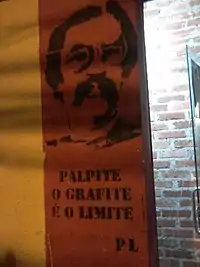Paulo Leminski
Paulo Leminski Filho (August 24, 1944 – June 7, 1989) was a Brazilian poet, translator, literary critic, biographer, teacher and judoka. He was famous for his avant-garde concrete poems and haiku.
Paulo Leminski | |
|---|---|
 | |
| Born | Paulo Leminski Filho August 24, 1944 |
| Died | June 7, 1989 (aged 44) Curitiba, Paraná, Brazil |
| Nationality | Brazilian |
| Occupation | Poet, judoka, biographer, translator, teacher, literary critic |
Notable work | Catatau, Distraídos Venceremos, Agora É que São Elas, Haitropikais, Caprichos e Relaxos |
| Spouse(s) |
|
| Children | 3 |
| Parent(s) | Paulo Leminski II Áurea Pereira Mendes |
Biography
Leminski was born in Curitiba, in the Brazilian state of Paraná, in 1944. His father, Paulo Leminski II, was of Polish descent, and his mother, Áurea Pereira Mendes, was of Portuguese, Afro-Brazilian and indigenous descent. In 1958, Leminski was sent to the Monastery of Saint Benedict in São Paulo, where he stayed throughout the whole year. During the First Congress of Brazilian Experimental Poetry in Belo Horizonte, Minas Gerais, he would meet Haroldo de Campos, who would become one of his long-time friends and major influences. In 1961, with only seventeen years old, he would marry Neiva Maria de Sousa, a plastic artist; their relationship would last for seven years, until they divorced. In 1964 he published his first poems in the magazine Invenção, founded by Décio Pignatari, Haroldo de Campos and his brother Augusto. In 1965 he became a history and creative writing teacher, even though he had never finished college. He was also an expert judo sensei.
In 1968 he married for the second time, now with also poet Alice Ruiz, and had with her three children: Miguel Ângelo (who died prematurely due to a lymphoma), Áurea (named after Leminski's mother) and Estrela Ruiz Leminski, who would also become a poet, artist and musician. He moved temporarily to Rio de Janeiro in 1969, returning to Curitiba in the following year.
In 1975, his first major work, Catatau, was published. It is an experimental novel, written in prose poetry, dealing with an imaginary visit of philosopher René Descartes to Brazil alongside Prince John Maurice of Nassau during the Dutch invasions of Brazil in the 17th century. Catatau would draw the attention of some of the most important cultural personalities of the time, such as Caetano Veloso, Gilberto Gil, Tom Zé and Moraes Moreira. In the following years he would publish some anthologies of his poems, the most notable ones being Distraídos Venceremos, Haitropikais (a collection of his haiku) and Caprichos e Relaxos. His second avant-garde novel, Agora É que São Elas, was published in 1984; however, it was not as well-received as Catatau.
Leminski was a polyglot; he knew French, English, Spanish, Japanese, Latin and Greek. He translated into Portuguese works by Petronius, John Fante, Alfred Jarry, James Joyce, Samuel Beckett and Yukio Mishima. An enthusiast of the culture of Japan, Leminski would write a biography of famous 17th-century haiku poet Matsuo Bashō in 1983. He also authored biographies of Leon Trotsky, João da Cruz e Sousa and Jesus Christ.
In 1988, Leminski divorced Alice Ruiz after a 20-year marriage, with whom he was working in conjunction with in his last poetry book, La Vie en close, that was published posthumously in 1991.
Leminski was a heavy drinker, and died on June 7, 1989, of liver cirrhosis.
Works
Poetry
- 40 Clics em Curitiba (1976)
- Polonaises (1980)
- Não Fosse Isso e Era Menos/Não Fosse Tanto e Era Quase (1980)
- Tripas (1980)
- Caprichos e Relaxos (1983)
- Haitropikais (1985 – in partnership with Alice Ruiz)
- Um Milhão de Coisas (1985)
- Distraídos Venceremos (1987)
- La Vie en close (1991 – posthumous; in partnership with Alice Ruiz)
- O Ex-Estranho (1996 – posthumous)
Prose
- Catatau (1975)
- Agora É que São Elas (1984)
- Metamorfose (1994 – posthumous)
Biographies
- Matsuo Bashō (1983)
- Jesus (1984)
- Cruz e Sousa (1985)
- Trotsky: A Paixão Segundo a Revolução (1986)